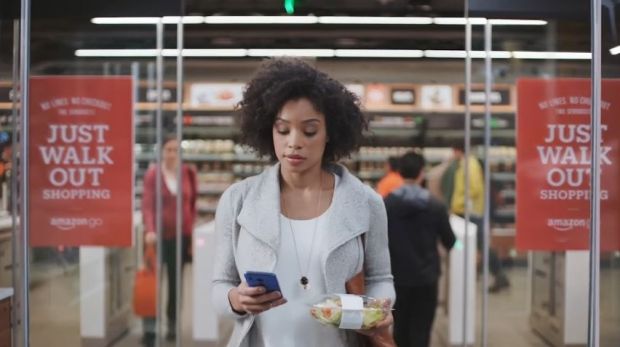Amazon has revealed that it will open a brick-and-mortar grocery store called Amazon Go, an ambitious bid by the once online-only retailer to gobble up more of Americans' shopping dollars by taking the fight more directly to traditional supermarkets.
The store will be powered by a web of technology that allows customers to fill up their shopping bags and walk out without going through a checkout process, a concept that has long been discussed in the retail industry but that has not been implemented at any major US stores. The idea is that it will shave time off the shopping experience.
More Digital Life Videos
Say goodbye to checkout queues?
Amazon Go stores will let customers grab groceries and just walkout with the total bill charged to your Amazon account.
Here's how Amazon Go will work: Customers download an app and then swipe their smartphones as they walk through the store's entrance. Then they just start picking up groceries. In a process that the company does not describe except to say that it involves such capabilities as computer vision, machine learning and artificial intelligence, every item the shoppers tuck into their bags or carts is tracked on the phone. If an item is put back on the shelf, it's deleted. As the shoppers exit, their total bill is calculated, a digital receipt appears on their phones and their Amazon account is charged. This video produced by the company offers some visuals that might help you imagine what that will look like:
The store is set to open in Seattle, Amazon's hometown, in early 2017. And its arrival could end up posing some critical questions for the wider retail industry. For starters, Amazon Go will probably need fewer workers than traditional stores that rely on cashiers and clerks. If shoppers respond favourably to this low-touch customer service model, it might end up encouraging other chains to give similar set-ups a try and save labour costs.
If Amazon Go is successful and is expanded widely, it could put serious competitive pressure on a wide range of retailers. At just 1800 square feet, Amazon Go looks to be targeting so-called fill-in trips, the kind of quick errand a shopper does when she just needs a couple of items. In recent years, drug stores and convenience stores have proved to be potent competitors to supermarkets for these kinds of shopping trips.
And then there's the fact that the company is promising that it will sell prepared foods made by "on-site chefs," meaning it will be fighting for the same breakfast, lunch and dinner spending that fast-casual and take-away restaurants currently vie for. Amazon Go also plans to sell pre-packaged meal kits that contain ingredients to make a home-cooked dinner for two.
Amazon's decision to sell groceries in physical stores would seem to be an acknowledgment of how hard it has proven to sell these kinds of goods on the internet. Despite the explosive growth of e-commerce overall, grocery has largely remained an old-school business.

And Amazon Go will face no shortage of challenges as it aims to transform the model. Filling up one's refrigerator has long been a convenience-centric errand, one in which the closest store to your house is often the one that gets your money. It will take a long time — and gobs of money — for Amazon to build out that kind of store network. And it's not a sure thing that what it calls "Just Walk Out technology" will win customers over. What if it turns out to be buggy? What if some shoppers find it off-putting and impersonal?
Major grocers were likely not shocked by Amazon's announcement: Rumours have been circulating for months that the company planned to open brick-and-mortar stores that sold food. And the e-commerce company has already shown interest in physical retailing by opening bookstores.
The Washington Post














9 comments
New User? Sign up